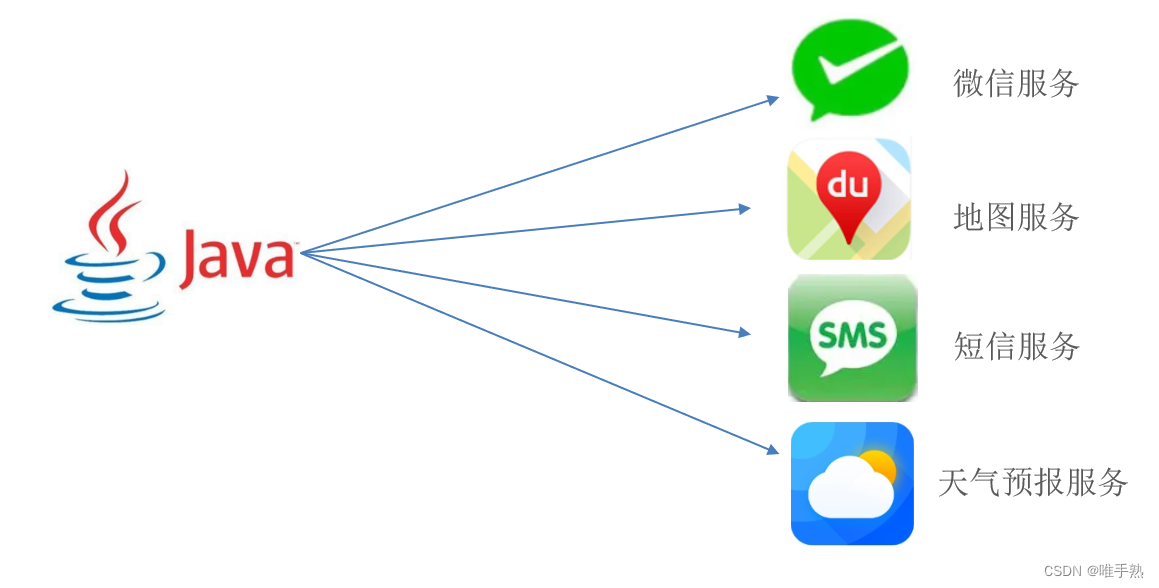需求:在当前模块对其他模块/服务的接口发送请求。
扩展想法:可以利用它实现一个小的接口测试工具(例如:postman)、分布式微服务快速开发的调用个接口的框架工具。
1.1 介绍
HttpClient 是Apache Jakarta Common 下的子项目,可以用来提供高效的、最新的、功能丰富的支持 HTTP 协议的客户端编程工具包,并且它支持 HTTP 协议最新的版本和建议。

HttpClient作用:
-
发送HTTP请求
-
接收响应数据
HttpClient应用场景:
当我们在使用扫描支付、查看地图、获取验证码、查看天气等功能时

其实,应用程序本身并未实现这些功能,都是在应用程序里访问提供这些功能的服务,访问这些服务需要发送HTTP请求,并且接收响应数据,可通过HttpClient来实现。

HttpClient的maven坐标:
<dependency>
<groupId>org.apache.httpcomponents</groupId>
<artifactId>httpclient</artifactId>
<version>4.5.13</version>
</dependency>HttpClient的核心API:
-
HttpClient:Http客户端对象类型,使用该类型对象可发起Http请求。
-
HttpClients:可认为是构建器,可创建HttpClient对象。
-
CloseableHttpClient:实现类,实现了HttpClient接口。
-
HttpGet:Get方式请求类型。
-
HttpPost:Post方式请求类型。
HttpClient发送请求步骤:
-
创建HttpClient对象
-
创建Http请求对象
-
调用HttpClient的execute方法发送请求
1.2 入门案例
对HttpClient编程工具包有了一定了解后,那么,我们使用HttpClient在Java程序当中来构造Http的请求,并且把请求发送出去,接下来,就通过入门案例分别发送GET请求和POST请求,具体来学习一下它的使用方法。
1.2.1 GET方式请求
如果在项目中已经引入了aliyun-sdk-oss坐标也可以直接使用,已经集成了它的坐标。:
<dependency>
<groupId>com.aliyun.oss</groupId>
<artifactId>aliyun-sdk-oss</artifactId>
</dependency>上述依赖的底层已经包含了HttpClient相关依赖。

故选择导入或者不导入均可。
进入到sky-server模块,编写测试代码,发送GET请求。
实现步骤:
-
创建HttpClient对象
-
创建请求对象
-
发送请求,接受响应结果
-
解析结果
-
关闭资源
测试(理解一下就行,重点在封装工具使用)
创建测试类
在访问自己的http://localhost:8080/user/shop/status请求时,需要提前启动项目。
import com.alibaba.fastjson.JSONObject;
import org.apache.http.HttpEntity;
import org.apache.http.client.methods.CloseableHttpResponse;
import org.apache.http.client.methods.HttpGet;
import org.apache.http.client.methods.HttpPost;
import org.apache.http.entity.StringEntity;
import org.apache.http.impl.client.CloseableHttpClient;
import org.apache.http.impl.client.HttpClients;
import org.apache.http.util.EntityUtils;
import org.junit.jupiter.api.Test;
import org.springframework.boot.test.context.SpringBootTest;
//@SpringBootTest
public class HttpClientTest {
/**
* 测试通过httpclient发送GET方式的请求
*/
@Test
public void testGET() throws Exception{
//创建httpclient对象
CloseableHttpClient httpClient = HttpClients.createDefault();
//创建请求对象
//HttpGet httpGet = new HttpGet("http://localhost:8080/user/shop/status");
HttpGet httpGet = new HttpGet("http://www.baidu.com/");
//发送请求,接受响应结果
CloseableHttpResponse response = httpClient.execute(httpGet);
//获取服务端返回的状态码
int statusCode = response.getStatusLine().getStatusCode();
System.out.println("服务端返回的状态码为:" + statusCode);
//获取响应体
HttpEntity entity = response.getEntity();
String body = EntityUtils.toString(entity);
System.out.println("服务端返回的数据为:" + body);
//关闭资源
response.close();
httpClient.close();
}
测试结果:

1.2.2 POST方式请求
在HttpClientTest中添加POST方式请求方法,相比GET请求来说,POST请求若携带参数需要封装请求体对象,并将该对象设置在请求对象中。
实现步骤:
-
创建HttpClient对象
-
创建请求对象
-
发送请求,接收响应结果
-
解析响应结果
-
关闭资源
/**
* 测试通过httpclient发送POST方式的请求
*/
@Test
public void testPOST() throws Exception{
// 创建httpclient对象
CloseableHttpClient httpClient = HttpClients.createDefault();
//创建请求对象
HttpPost httpPost = new HttpPost("http://localhost:8080/admin/employee/login");
//构造接口请求参数
JSONObject jsonObject = new JSONObject();
jsonObject.put("username","admin");
jsonObject.put("password","123456");
StringEntity entity = new StringEntity(jsonObject.toString());
//指定请求编码方式
entity.setContentEncoding("utf-8");
//数据格式
entity.setContentType("application/json");
httpPost.setEntity(entity);
//发送请求
CloseableHttpResponse response = httpClient.execute(httpPost);
//解析返回结果
int statusCode = response.getStatusLine().getStatusCode();
System.out.println("响应码为:" + statusCode);
HttpEntity entity1 = response.getEntity();
String body = EntityUtils.toString(entity1);
System.out.println("响应数据为:" + body);
//关闭资源
response.close();
httpClient.close();
}测试结果:

二、将其封装成一个工具类来使用

创建工具类HttpClientUtil.java
import com.alibaba.fastjson.JSONObject;
import org.apache.http.NameValuePair;
import org.apache.http.client.config.RequestConfig;
import org.apache.http.client.entity.UrlEncodedFormEntity;
import org.apache.http.client.methods.CloseableHttpResponse;
import org.apache.http.client.methods.HttpGet;
import org.apache.http.client.methods.HttpPost;
import org.apache.http.client.utils.URIBuilder;
import org.apache.http.entity.StringEntity;
import org.apache.http.impl.client.CloseableHttpClient;
import org.apache.http.impl.client.HttpClients;
import org.apache.http.message.BasicNameValuePair;
import org.apache.http.util.EntityUtils;
import java.io.IOException;
import java.net.URI;
import java.util.ArrayList;
import java.util.List;
import java.util.Map;
/**
* Http工具类
*/
public class HttpClientUtil {
static final int TIMEOUT_MSEC = 5 * 1000;
/**
* 发送GET方式请求
* @param url
* @param paramMap
* @return
*/
public static String doGet(String url,Map<String,String> paramMap){
// 创建Httpclient对象
CloseableHttpClient httpClient = HttpClients.createDefault();
String result = "";
CloseableHttpResponse response = null;
try{
URIBuilder builder = new URIBuilder(url);
if(paramMap != null){
for (String key : paramMap.keySet()) {
builder.addParameter(key,paramMap.get(key));
}
}
URI uri = builder.build();
//创建GET请求
HttpGet httpGet = new HttpGet(uri);
//发送请求
response = httpClient.execute(httpGet);
//判断响应状态
if(response.getStatusLine().getStatusCode() == 200){
result = EntityUtils.toString(response.getEntity(),"UTF-8");
}
}catch (Exception e){
e.printStackTrace();
}finally {
try {
response.close();
httpClient.close();
} catch (IOException e) {
e.printStackTrace();
}
}
return result;
}
/**
* 发送POST方式请求
* @param url
* @param paramMap
* @return
* @throws IOException
*/
public static String doPost(String url, Map<String, String> paramMap) throws IOException {
// 创建Httpclient对象
CloseableHttpClient httpClient = HttpClients.createDefault();
CloseableHttpResponse response = null;
String resultString = "";
try {
// 创建Http Post请求
HttpPost httpPost = new HttpPost(url);
// 创建参数列表
if (paramMap != null) {
List<NameValuePair> paramList = new ArrayList();
for (Map.Entry<String, String> param : paramMap.entrySet()) {
paramList.add(new BasicNameValuePair(param.getKey(), param.getValue()));
}
// 模拟表单
UrlEncodedFormEntity entity = new UrlEncodedFormEntity(paramList);
httpPost.setEntity(entity);
}
httpPost.setConfig(builderRequestConfig());
// 执行http请求
response = httpClient.execute(httpPost);
resultString = EntityUtils.toString(response.getEntity(), "UTF-8");
} catch (Exception e) {
throw e;
} finally {
try {
response.close();
} catch (IOException e) {
e.printStackTrace();
}
}
return resultString;
}
/**
* 发送POST方式请求
* @param url
* @param paramMap
* @return
* @throws IOException
*/
public static String doPost4Json(String url, Map<String, String> paramMap) throws IOException {
// 创建Httpclient对象
CloseableHttpClient httpClient = HttpClients.createDefault();
CloseableHttpResponse response = null;
String resultString = "";
try {
// 创建Http Post请求
HttpPost httpPost = new HttpPost(url);
if (paramMap != null) {
//构造json格式数据
JSONObject jsonObject = new JSONObject();
for (Map.Entry<String, String> param : paramMap.entrySet()) {
jsonObject.put(param.getKey(),param.getValue());
}
StringEntity entity = new StringEntity(jsonObject.toString(),"utf-8");
//设置请求编码
entity.setContentEncoding("utf-8");
//设置数据类型
entity.setContentType("application/json");
httpPost.setEntity(entity);
}
httpPost.setConfig(builderRequestConfig());
// 执行http请求
response = httpClient.execute(httpPost);
resultString = EntityUtils.toString(response.getEntity(), "UTF-8");
} catch (Exception e) {
throw e;
} finally {
try {
response.close();
} catch (IOException e) {
e.printStackTrace();
}
}
return resultString;
}
private static RequestConfig builderRequestConfig() {
return RequestConfig.custom()
.setConnectTimeout(TIMEOUT_MSEC)
.setConnectionRequestTimeout(TIMEOUT_MSEC)
.setSocketTimeout(TIMEOUT_MSEC).build();
}
}记得导入相关依赖。























 5214
5214











 被折叠的 条评论
为什么被折叠?
被折叠的 条评论
为什么被折叠?










